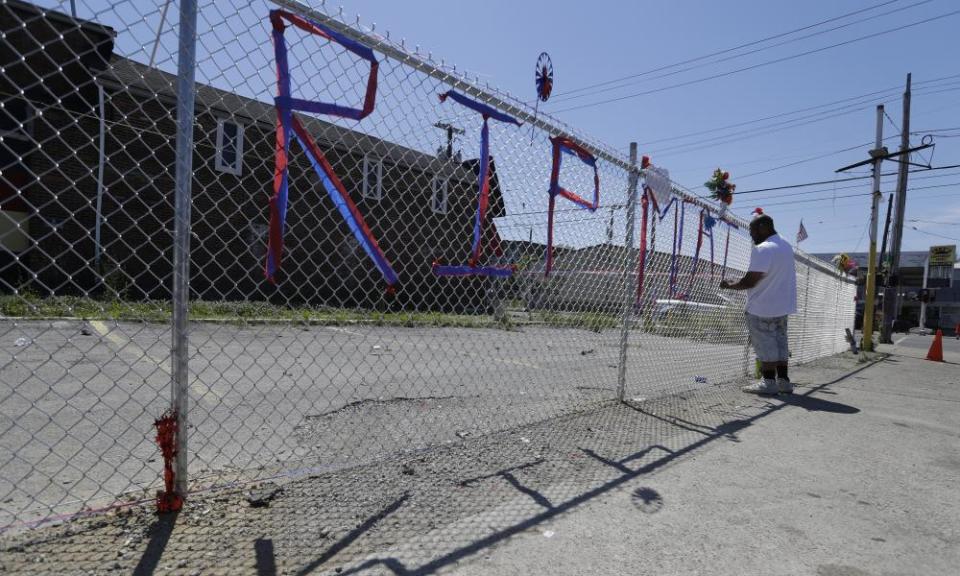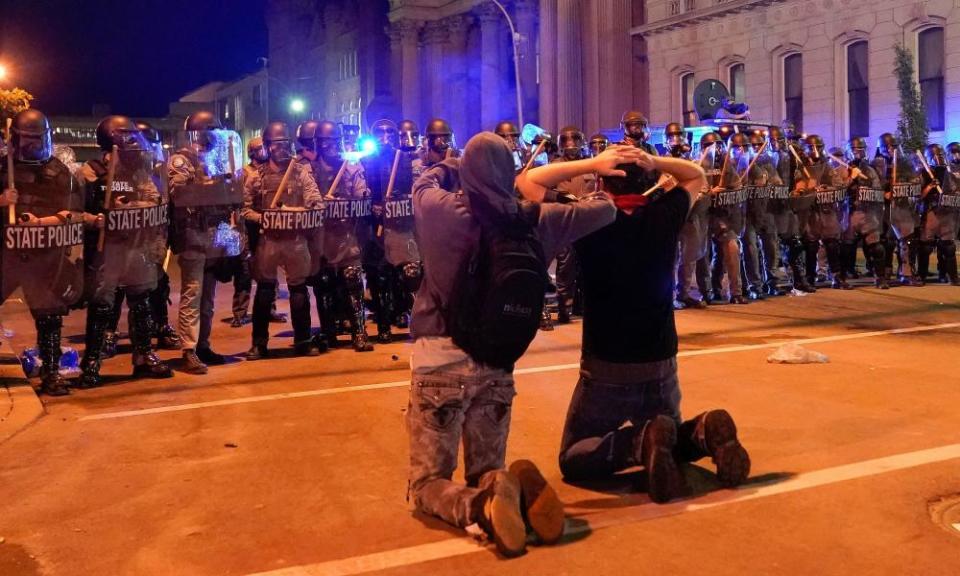‘I cannot stand it’: family of Louisville man shot dead by police speak out

In the moments before he was shot dead by law enforcement this week, David McAtee – otherwise known as YaYa or “the barbecue man” – was doing what he always did: cooking up meat for the crowds gathered at the intersection of Broadway and 26th in Louisville, Kentucky’s predominantly black West End.
It was the second night of curfew in Louisville. But here, a few miles from the center of the downtown protests over the March police killing of 26-year-old black ER tech Breonna Taylor, that were ignited following the May police killing of George Floyd – curfew was being ignored.
Related: Breonna Taylor’s mother calls for end to violence after seven are shot in protest
People were sitting around at the Dino’s gas station and food mart across the street listening to music and having a good time. At his barbecue stand, McAtee was busy shuffling between the grills made out of oil drums that he cooked on and the kitchen. He had hoped to open a bricks-and-mortar restaurant one day.
None of them had the faintest idea that McAtee’s name would soon join the long list of those chanted by protesters across the US calling for an end to police violence against people of color.
“It was just a normal day. People just having fun. Not nobody was about trouble,” McAtee’s nephew, Marvin McAtee, told the Guardian as he stood next to the bullet-pocked wall beside the kitchen entrance. “Nothing that serious for the marshals to come over for us.”

It was just after midnight on 1 June when at least two trucks of national guard troops and a number of Louisville metro police department (LMPD) officers arrived at the intersection with the goal of breaking up the crowd that was gathered there in violation of curfew. Protesters downtown had already been dispersed earlier with teargas, pepper balls and baton rounds. Now they were trying to put the city to bed.
In surveillance footage released by LMPD, officers can be seen shooting pepper balls in the direction the people gathered next to the grills at YaYa’s BBQ. The crowd appears to panic and flees into the kitchen, where McAtee had gone just before the arrival of the police and troops. He pushes through the crowd to get to the door to see what is going on, his right hand on his hip where he appears to be wearing a pistol. He takes a step outside the door and raises his arm in the air – a motion consistent with firing a warning shot – before rushing back inside and collapsing on the ground.
“A curfew? You come and shoot at people for a curfew? I cannot stand it,” said Marvin McAtee, who worked with his uncle cooking barbecue. “I have no hate for the police or nothing. It’s something that went wrong and they just need to apologize and say ‘we was wrong’. I don’t want no money, I don’t want no lawsuit. Just say: ‘We made wrong decisions.’”

Marvin McAtee said McAtee used to feed cops who worked his part of town for free. Sometimes they would throw down money when his back was turned, but he’d never ask law enforcement for money.
Despite that past relationship, “no police came here and shook my hand and said ‘I’m sorry for your loss’ or nothing”, said Marvin McAtee.
I don’t want no lawsuit. Just say: ‘We made wrong decisions'
Marvin McAtee
Police say two LMPD officers and two national guards troops discharged their weapons after McAtee fired a gun, though have not said whose bullets hit and killed McAtee. The surveillance footage does not show McAtee firing a weapon. There is no body-cam footage of the incident despite requirements for LMPD officers to wear and activate the devices.
Marvin McAtee says his uncle would not fire at police and was defending his shop in a chaotic situation. He did not see his uncle fire a shot. Amid the unrest across the US in recent days, business owners have taken to carrying weapons and firing shots in the air to dissuade looters.
McAtee’s killing prompted quick and sweeping changes: Louisville’s mayor, Greg Fischer. fired the police chief and police have, in the days since, taken a markedly less aggressive stance on protesters after the force had faced accusations of heavy-handedness and teargassing peaceful demonstrators. On Thursday, the curfew ended.
But McAtee’s death bore a striking resemblance to the killing of Taylor, raising questions over whether meaningful reform was indeed under way.
Related: Breonna Taylor shooting: hunt for answers in case of black woman killed by police
Taylor was shot and killed by plainclothes LMPD officers serving a no-knock warrant in a narcotics investigation in March. Thinking they were witnessing a home invasion, her boyfriend, Kenneth Walker. fired a shot and hit an officer in the leg after the door of her apartment was breached, prompting a barrage of gunfire that saw Taylor – an EMT who had been working in Louisville hospitals during the coronavirus pandemic – hit eight times. No drugs were found in the apartment and despite widespread protester demands that the officers involved be fired and arrested, none have been fired yet.
Again, there is no body-cam footage of Taylor’s killing because officers were not wearing the devices. Both killings have raised questions over why cops were there in the first place. And both have prompted cops and the city to pledge they’ll do some things differently from then on.

But while officers involved in the killing of George Floyd in Minneapolis have been arrested and face charges, officers in both of Louisville’s killings remain employed by the police force as investigations continue.
Like many cities across the US, Louisville saw unrest and riots in the aftermath of Martin Luther King Jr’s assassination in 1968. Like today, the nationwide unrest was compounded in Louisville by local incidents: weeks before the assassination, a local black man had been beaten by a Louisville cop, driving even more anger. Segregation in the city was exacerbated by the unrest as white residents left the western part of the city. The city remains heavily segregated today.
In more recent times, Louisville was “almost the Ferguson, Missouri story before Ferguson, Missouri” in 2004 according to Christopher 2X, an anti-violence activist who runs the organization Game Changers.
In January of that year, 19-year-old Mike Newby was shot and killed by undercover cop named McKenzie Mattingly during an attempted drug buy sting. Mattingly said he had feared for his life, but Newby was shot three times in the back. The killing stoked protests in Louisville. Mattingly was charged with murder, but acquitted.
This time, Deonte Hollowell, a professor at Louisville’s Spalding University who studies the relationship between African American communities and the police, says he’s hopeful that the protest movement will lead to change.
“I think it’s possible because I think there’s so many people that are passionate about not just getting justice for YaYa and Breonna, but changing the system,” he said.
But, he added, there’s a lot of work to be done before anger on the street will lessen.
I don’t think at this point the anger is going anywhere until those officers are arrested
Deonte Hollowell
“I don’t think at this point the anger is going anywhere until those officers are arrested,” he said. “And even then, there’s so many other layers to this that that would be a satisfactory situation, but it wouldn’t be the end by any means. And I think that most people, or many people, that are protesting understand that.”
Residents of the western part of Louisville, where McAtee was killed, often consider the area ignored by the city. It’s a part of town where the inequality and damage done by redlining is apparent.
“We haven’t been funded in the West End for a long time. Not since the 1968 riot,” said Ruby Johnson, 38, as she volunteered handing out donated food to the community in front of a boarded-up Kroger supermarket a block from YaYa’s BBQ that had been looted in the aftermath of McAtee’s death. “Ever since then they pulled out and they ain’t ever been back. And that’s the truth. I been down here my whole life.”
As she spoke, she pointed out abandoned buildings, mentioning the businesses that once occupied them but have disappeared. On the street where she owns a nursery, over a third of the homes are abandoned.
Cherrie Vaughn, 42, was nearby at the shuttered Kroger gas station where she had been leading prayer groups following McAtee’s death. She said she had faith that the upheavals being witnessed in Louisville and around the country would lead to lasting change – not only as far as the relationship between African American communities and police, but as far as equity and opportunity.
“I feel like right now the world is at a turning point,” she said. “We’ve been saying it for so long, we’ve been saying it for so long, we’ve been saying it for so long and now we’re at this brick wall and it has to come down.”

 Yahoo News
Yahoo News 